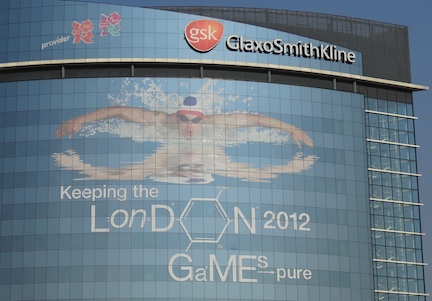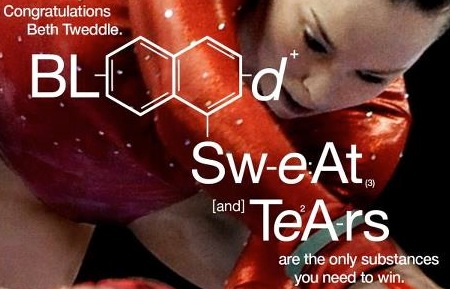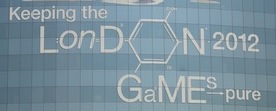 |
 |
| Beth Tweddle |
The Building Ad |
In these two images we see the "Exceptions" to the campaign. In the first image, gymnast Beth Tweddle is performing on the uneven bars and an unspecified swimmer graces the front of the GSK building in the other.
 |
At first glance, Beth Tweddle's ad looks like the other ads in the campaign. It was the first image of the campaign I found and it was the only one I found featuring a female athlete. The ad is an up close shot of Beth Tweddle flying through the air as she is deep in concentration as to not miss the uneven bar she is performing on. The up close shot and upward angle do not differ from the distance and point of view explained in the previous section nor does the text in the corners and bottom of the ad differ. The difference is seen in the fact that she is a woman and in the text/graphic in the center. As was noted in the last section, the central text and focal point of the ad was a quote by the featured male athlete. Here that is not the case. The text/graphic for the ad reads, "Congratulations Beth Tweddle. Blood, Sweat, and Tears are the only substances you need to win."
Beth Tweddle is not given a voice but is instead spoken for. The advertisement
informs her of what she needs in order to succeed. In doing this, the advertisement
campaign positions her as a subordinate to her male counterparts. Historically, sports
have been "perceived as a traditionally male role" and this campaign can be seen as
reiterating that (Grau, 55). The campaigns "approach to female supporting roles reinforces
women's subordinate position" (Li, 386). She is just as qualified as the male athletes
are but out of all of the ads, GSK decided to change the main text of her ad up leaving
her as an outsider-the only outsider-in two separate occasions. As Goodman et al. argue
based on their findings through an analysis of the 2000 Summer Olympics, "male and female
athletes were equally portrayed as Warriors. However, male athletes were more likely to be
portrayed as preparing for and doing battle successfully while female athletes were more
likely to be celebrated for their athletic skills and achievements" (Goodman, 374). This
is exactly what is seen here within this ad. Every one of the athletes is in mid-competition
showing their warrior-like determination, but through the text, the male athletes are making
a bold statement that is used to fuel them through the "battle" and the woman is more
cheerfully being celebrated.
|
|
Another way to look at Beth Twiddle's role is through the common myth that male athletes
dope more than women do. Because society is more often exposed to male athletes in general,
the male athletes caught doping are placed under greater scrutiny. The campaign's
underrepresentation of women athletes could simply be because women aren't the ones who
are believed to be doping in the first place. In this case, it is a positive that she is
the only female. She is also viewed from the same camera angle as the men. Bissell et al.
argue that "camera angle...often followed traditional gendered expectations with men shown
from low camera angle...while women were shown from high angles" (Bissell, 483). In this campaign though, in terms of camera angle, Beth Tweddle is equal to the male athletes. She is looked up to just as the men are. Both perspectives are arguable as is seen but I feel that this ambiguity allows for both male and female audience members to be able to connect with her as an athlete. In turn, that further benefits GSK.
|
 |
 |
As the other part of the exception, the last image of the campaign we will look at was
meant for all to see. Placed on the front of the GSK building in Brentford, London England,
the image is of a male swimmer facing the crowd with the text "keeping the London 2012 games
pure". The athlete, swimming butterfly is unspecified. The audience can tell it is a male
swimmer but that is all. As will be discussed on a later page, he is the only athlete that
isn't linked directly to Great Britain. He is the only athlete that is positioned to be
looking directly at the camera as well. This can be due to where the ad is located. Unlike
the other ads, this ad was made for the front of the GSK building. Geographically, the building,
especially with this kind of decoration, is hard for tourists to miss as they leave Heathrow
airport and head into the city. As Rajan et al. state, "sports are an international language
everyone can relate to" (Rajan). It is a reminder of what GSK is doing to make the games as
honest and pure as possible while also reassuring the legitimacy of sports which Quick
argues has been compromised by the presence of steroids (Quick, 255). They want the
tourists to have no doubt in their mind when it comes to the Olympics. From being there
and going to the 2012 Olympics, it is a long journey to that point and the last thing you
want is to realize the person you were cheering on was cheating. Like Von Burg explains,
"when such athletic accomplishments are called into question and the accounts of success
become fragmented, the faith in the symbolic value of these athletes...are shaken" (Von Burg, 352-3). That goes against everything the Olympics stand for. Even if the allegations aren't true or it was "only once" they do affect the integrity of the games as well as sports in general just as Quick explained.. Seeing that sign with the swimmer looking right at us with welcoming arms as you enter the city, lets the tourist who sees it take a big sigh of relief. They didn't come all that way to see someone cheat and now they won't have to worry about it either.
|
|
The ad on the building also serves as the only ad that uses GSK's claim to anti-doping as a focal point of the ad and not just as the information we see at the bottom. Since it is the ad that welcomes all who come into London, GSK used "Keeping the London 2012 Games Pure" to show the world that they want London to be seen as a "pure" place. The ads position the athletes as role models and GSK wants people to see that the athletes are worthy of being such. When talking about the attempt to end doping in Major League Baseball in the United States, Butterworth makes the argument that "indeed, over and over steroids have been depicted as the great threat to the game's purity and innocence, especially because the athletes who take them have the power to influence America's children" (Butterworth, 151). Putting the same idea onto the world stage, Olympic and Paralympic athletes have a huge influence over children in particular. If GSK didn't decide to make such a bold statement and advertise their goal of keeping performance-enhancing drugs out of the Olympics and Paralympics, they run the risk of letting steroid use get out of hand. The more young children that see their favorite athlete use something to enhance their play, the more likely they are to want to or feel the need to also.
|
 |
While these two exceptions have clear differences that set them apart from the core campaign, there is no doubt that they contribute to showing an athlete's power to persuade an audience. From here, you can head backwards and review the campaign or move forward to the themes of sports.
The Core Campaign
The Themes of Sports
Citations
Beth Tweddle image
Bissell, Kim, and Stephen D. Perry. "Introduction To The Special Issue On Olympics, Media, And Society." Mass Communication & Society 15.4 (2012): 481-484. Communication & Mass Media Complete. Web. 9 May 2014.
Butterworth, Michael L. "Purifying The Body Politic: Steroids, Rafael Palmeiro, And The Rhetorical Cleansing Of Major League Baseball." Western Journal Of Communication 72.2 (2008): 145-161. Communication & Mass Media Complete. Web. 9 May 2014.
Goodman, J. Robyn, Lisa L. Duke, and John Sutherland. "Olympic Athletes And Heroism In Advertising: Gendered Concepts Of Valor?." Journalism & Mass Communication Quarterly 79.2 (2002): 374-393. Communication & Mass Media Complete. Web. 1 Apr. 2014.
Grau, Stacy Landreth, Georgina Roselli, and Charles R. Taylor. "Where's Tamika Catchings? A Content Analysis Of Female Athlete Endorsers In Magazine Advertisements." Journal Of Current Issues & Research In Advertising (CTC Press) 29.1 (2007): 55-65. Communication & Mass Media Complete. Web. 1 Apr. 2014.
Li, Hongmei. "The Gendered Performance At The Beijing Olympics: The Construction Of The Olympic Misses And Cheerleaders1." Communication Theory (10503293) 21.4 (2011): 368-391. Communication & Mass Media Complete. Web. 9 May 2014.
Quick, Brian L. "Applying The Health Belief Model To Examine News Coverage Regarding Steroids In Sports By ABC, CBS, And NBC Between March 1990 And May 2008." Health Communication 25.3 (2010): 247-257. Communication & Mass Media Complete. Web. 9 May 2014.
Rajan, A. Kaleb, and C. Johnson Premkumar. "Sports: A Universal Language Of Cultural Exchange, Brotherhood And Empowerment." Language In India 13.4 (2013): 128-132. Communication & Mass Media Complete. Web. 9 May 2014.
Outdoor image on building by author





